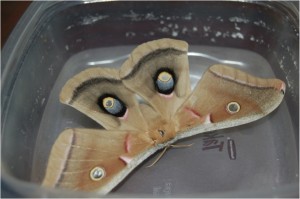
The beautiful Polyphemus moth will only be found in areas where its host plants grow. Native oaks, ash, apple, dogwood, elm and maples are favored foods for Polyphemus caterpillars
I’ve heard many folks talking about the importance of planting native plants, but I’ve never heard anyone (from Texas anyway) try and convince people that native plants are good because they attract more insects. Yet that’s exactly what I’d like to do.
Most of the time you’ll hear that native plants should be more widely planted because they are well adapted to our climate. This is true, of course, but so are many exotic plants. In fact the Texas urban landscape seems to have more exotic (or alien) plants than native plant species. I’m not sure why this is, other than our continual human discontent with what we’ve been given, and in some cases the fact that many times alien plants seem to be more trouble-free than native plants.
Research by Dr. Doug Tallamy at the University of Delaware has proved the latter. He and his graduate students have found that native plants have 3.2 times as many different kinds of insects attacking them, and a whopping 35X more Lepidoptera species (in terms of weight or biomass) feeding on them than alien plants. Yet Tallamy has written a whole book trying to get people to use more native plants for this very reason. So what gives?
Tallamy’s point, and I happen to agree with him, is that in an increasingly urban and ever more-ecologically fragmented country, we need to bring more biological diversity in our urban landscapes. In fact it may be absolutely essential if we are going to maintain certain wildlife species, including many songbirds. When we plant plants that make poor hosts for our native insect populations, we inadvertently take away the food source for many species of birds, reptiles, amphibians and mammals that might otherwise not mind sharing our communities with us. Think high-unemployment for scissor-tailed flycatchers, mockingbirds, sparrows, wrens, purple martins and others.
Some might say good riddance, “I don’t want wildlife in my backyard, let them stay in the woods where they belong!” But that’s the point. Our woodlands and prairies are disappearing at a rapid clip and soon there may be no where for them to relocate. That’s where making urban landscapes more wildlife-friendly comes in.
At this point some will–quite logically–say, “Alien plants don’t sound like such a bad idea if they have fewer pests. That means less hassle and maybe less need to treat my yard with pesticides.” But the types of insects Tallamy and others are finding on native plants don’t seem to be all that bad for the plants themselves. It turns out that when insects and plants adapt or evolve together over long periods of time, they learn to live with each other pretty well. The caterpillars that seem to festoon native plants are, in reality, pretty hard to find unless you know how to look for them. But birds know how to find them and in fact rely pretty heavily on caterpillars and other juicy insect life to feed themselves and their young.
So it turns out we can’t have our cake and eat it too. That is, we can’t have an insect-free backyard AND expect to be serenaded by all manner of songbirds in the morning. If you want birds and other wildlife, you have to create an environment that is insect-friendly. I plan to return to this subject more in Insect Updates, but remember that a yard without bugs, is a lot like apple pie without ice cream. It’s just not the full experience. And once you begin learning about the varied arthropod life in your backyard, I think you’ll find that insects don’t have to be bad neighbors.
So take some advice from a Texas entomologist. The next time you plant a new tree or shrub, or even flower, consider a native plant. The birds and the bees will thank you.